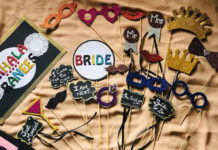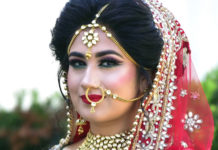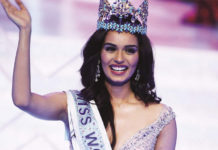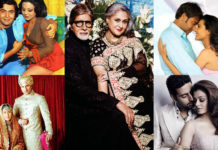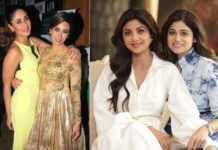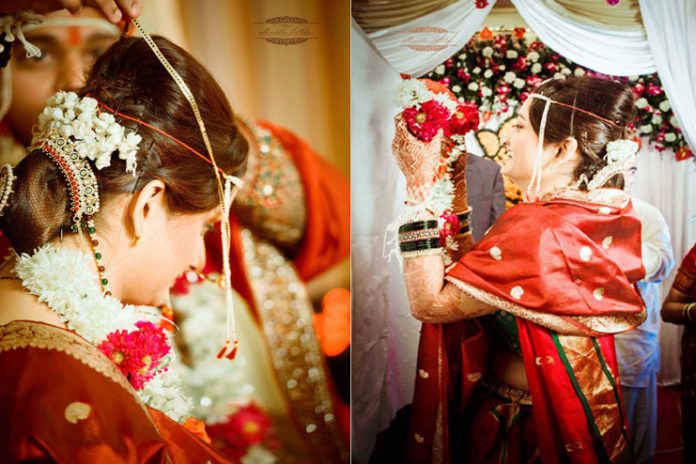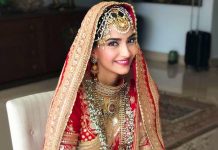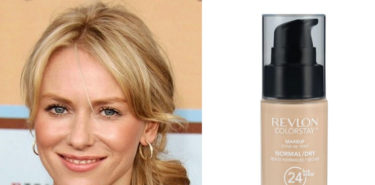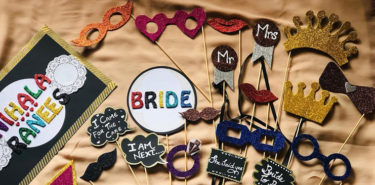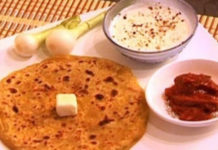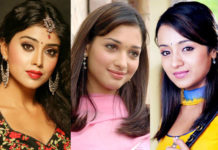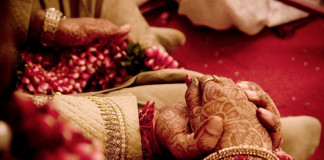Affiliate Disclaimer
Some links in this article are affiliate links. We may earn a small commission if you make a purchase through these links, at no extra cost to you. We only recommend products we find useful to our readersMaharashtra is the richest and most industrialised state in India. However, unlike weddings in other parts of India which are conducted with great pomp and show, traditional Maharashtrian weddings are simple, full of traditions and rituals and possess a cheerful vibe.
The foundation of a Marathi matrimony alliance is laid by finding a suitable counterpart and matching the horoscopes of the boy and the girl by the priest. If matched suitably, an auspicious date in line with the horoscopes of the prospective bride and groom is decided.
This is followed by preparations for the wedding, with pre-wedding rituals being performed simultaneously. One of the first pre-wedding rituals is Shakkar Puda which is a formal engagement ceremony which takes place at the bride’s house, when packets of sugar are exchanged between both the families to confirm the alliance.
The mother of the groom gives the bride a packet of sugar, a saree and puts a tilak on her forehead which signifies her approval to the union of the girl with her son. The bride and groom then exchange rings to seal the deal.
The mother of the bride then gives the groom a packet of sugar, pieces of clothing such as a shirt and a pair of trousers and confirms her agreeance to this alliance. Creation of the alliance is then celebrated with a grand feast for both the families.
A traditional Marathi wedding outfit is modest yet elegant. The bride wears a silk saree with broad gold borders and is draped in a kastha or trouser style where the saree is pulled between the legs and tucked in that the back, making it look like a trouser.
The saree is usually bright in colour and the most common combinations are yellow with green borders, green with red borders or mustard with purple borders. The traditional saree can be a Paithani saree which is nine metres long and has fine looking motifs embedded into it.
The accessories worn by a Maharashtrian bride is unique to the culture such as glass green bangles accompanied by the solid gold bangles given by the groom’s family and symbolise fertility and new life, Thusi which is a traditional necklace, the Nath which is the traditional nose ring made from pearls and diamonds, the armlets or vaaki which is made of gold and precious stones and a crescent shaped bhindi with a dot below it. The hair is usually tied up in a bun and decorated with flowers or ornaments.
The traditional attire of a Maharashtrian groom is a beige, cream or white coloured kurta worn with a white kacche or dhoti which has a thin golden border. They wear a decorate piece of cloth in silk or cotton silk cloth on their shoulder that is usually gold or red in colour. The traditional head gear work by a Maharashtrian groom is a turban also known as the Pheta. In some castes, a white cotton cap also known as the Gandhi cap is worn by the groom for the ceremony.
The most distinguishing feature in the attire of a Maharashtrian bride and groom is that they both wear a head band around their forehead known as Mundavalya. It is generally two strings of pearls tied horizontally across the forehead and two lines of pears hang down from the headband in front of the ears.
The rituals in a Marathi wedding are performed with a lot of verve and zeal. A traditional Marathi wedding is performed by a priest and usually encompasses the rituals of a typical Hindu wedding such as kanyadhaan (giving away of the bride by her father to the groom saying she is now his responsibility from now on), mangalsutra bandhan (tying of the mangalsutra, which is a necklace of black and gold beads, around the bride’s neck by the groom), sapthapadi (circumambulation of the bride and groom around the holy fire seven times, also known as pheras, vowing to be with each other for seven lives) and others
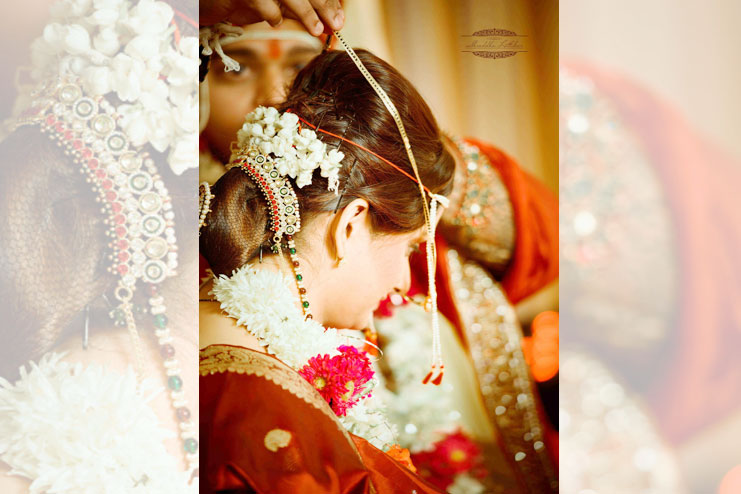
The couple are asked to stand facing each other and touch their foreheads which signifies that they will henceforth be putting their heads together in all their decisions in life. literally meaning putting their heads together for decision-making hereafter. They both promise to be devoted to each other and have progeny and grow their family tree.
Every ritual in a Marathi wedding has a vital significance and is more of a family affair rather than a pompous show of wealth and power. Most of the ceremonies occur in the early hours of the morning and afternoon. The reception ceremony usually takes place on the same day as the wedding ceremony in the evening. However nowadays for convenience people conduct the reception on the night before the actual wedding ceremony.
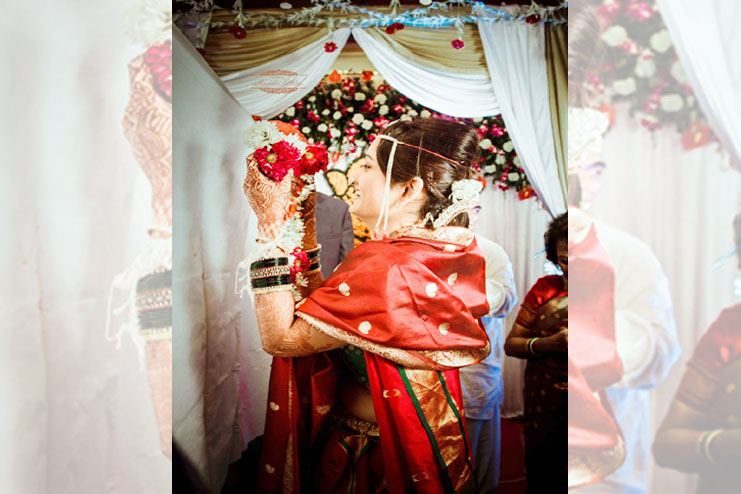
5 things That Make A Marathi Wedding Unique
- Except a lot of rich colours everywhere- it is all about beautiful silk sarees in auspicious colours such as green, gold, red and purple, traditional gold jewellery and accessories, and bright flowers.
- Most of the guests at a Maharashtrian wedding are family- extended family members and very close friends. Most guests wear traditional clothes and jewelry- honouring traditions is a big part of the Marathi culture.
- Food is a big part of a Marathi wedding. At a Maharashtrian wedding, expect that the menu would predominantly be vegetarian – especially in a Marathi Brahmin wedding. Though some people in Marathi castes eat meat, wedding ceremonies are often conducted in the temples and therefore the food served is religious food, which is vegetarian. Only at reception, Marathi people who eat non-vegetarian food serve meat dishes. A day after the wedding, Marathas who eat non-vegetarian food throw a huge feast of meat and vegetarian dishes to their family and close friends.
- As a Maharashtrian wedding is focused heavily on adhering to age old traditions and rituals, expect to be a participant in the many of the rituals if it is the wedding is of a close friend or relative.
- Be prepared to attend a few days of ceremonies. A traditional Marathi wedding can last anywhere between 2 to 3 days.
Overall it is an enriching experience and if you are lucky to take part in a Marathi wedding, it is likely that you will remember it for a long time to come.









